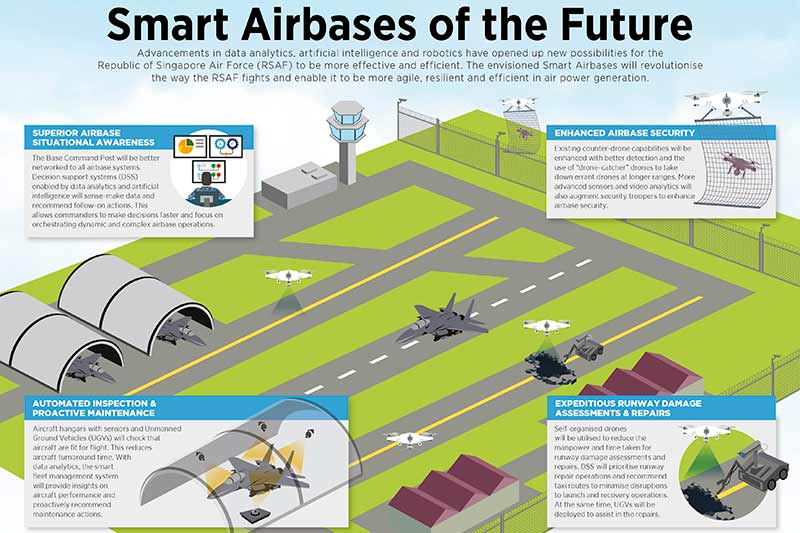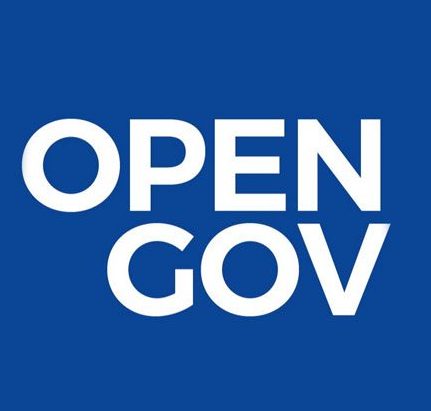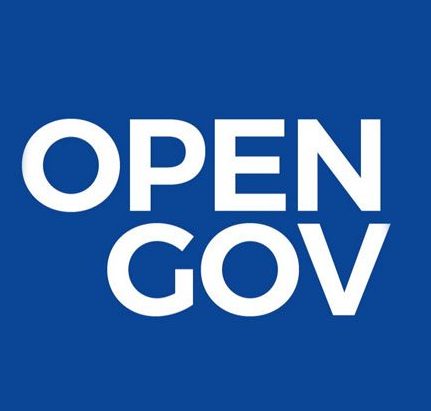
The Republic of Singapore Air Force (RSAF) and the Republic of Singapore Navy (RSN) are utilising technologies such as data analytics, artificial intelligence (AI) and robotics for more effective and efficient operations while reducing manpower needs.
Minister for Defence Dr Ng Eng Hen and Second Minister for Defence Mr Ong Ye Kung talked about these initiatives during the Defence Committee of Supply (COS) Debate in the Singapore Parliament on 2 March.
Smart Airbases
The RSAF, jointly with the Defence Science and Technology Agency (DSTA), is exploring the development of the Smart Airbase concept to be more effective and efficient in generating and sustaining air power for the Singapore Armed Forces (SAF).
A factsheet from the Ministry of Defence (MINDEF) Singapore explains that an airbase is an intricate and tightly-connected warfighting system. It has to generate the right number of aircraft in the right configuration, and to take off at the right time for missions. There is little margin for error.
In the envisaged Smart Airbases the Base Command Post will be better networked to all airbase systems, and decision support systems (DSS) enabled by data analytics and artificial intelligence will be used to make sense of voluminous amount of data and provide recommendations for follow-on actions.
This allows commanders to make decisions faster and focus on orchestrating dynamic and complex airbase operations.
There will also be more automation and unmanned systems in areas such as aircraft inspection and maintenance, airbase security, and runway damage assessments and repairs.
The factsheet lists four specific features of the future Smart Airbases. The first is Automated Aircraft Inspection. Aircraft turnaround time and the workload on the RSAF’s aircraft engineers will be reduced with an automated aircraft inspection system.
Instead of the current pre-flight and post-flight aircraft inspections, aircraft hangars will be equipped with sensors and Unmanned Ground Vehicles (UGVs) to perform checks to ensure that the aircraft are fit for flight.
The second feature is a Smart Fleet Management system being developed by RSAF and DSTA for more proactive maintenance. By applying data analytics to aircraft information, the system will be able to provide insights on aircraft performance and proactively recommend maintenance actions. Engineers will be able to pre-empt problems and carry out maintenance activities before system failure or before complex problems surface, which require more time and effort to resolve
The Smart Airbase will also be equipped with unmanned technologies for enhanced airbase security, operating alongside security troopers. Facial recognition and biometric verification will be implemented for access control into and within the airbases.
In addition, more advanced sensors and video analytics will be used to detect intrusions and suspicious activities. Existing counter-drone capabilities will also be enhanced with better detection and the use of “drone-catcher” drones to take down errant drones.
Self-organised drones will be used to expedite runway damage assessments and repairs and reduce manpower need for the same. Upon detection of surface anomalies, the DSS will prioritise runway repair operations and recommend taxi routes to minimise disruption to aircraft launch and recovery operations. UGVs will also be deployed concurrently to assist in the repair operations.
Smart Defence Initiatives by RSN

Singapore is a maritime nation situated amongst many small islands, and it has to deal with a porous maritime security environment. In addition, as a maritime trade hub, the waters that the RSN protects are extremely congested with both large merchant vessels and small craft transiting through the narrow Singapore Strait.
Innovative ship design
The RSN’s newest class of ships, the Littoral Mission Vessel (LMV), developed in partnership with the DSTA and Singapore Technologies Marine, features many innovative design concepts for both operations and engineering support. The design process adopted a novel “design the support” approach, where key downstream engineering and logistics support considerations were factored upfront in the vessel’s design.
Its stacked mast maximises sensor coverage while allowing maintenance to be carried out more efficiently, and has reduced time spent at dock for mast-related defects. In addition, the LMVs are designed to be more capable than the Patrol Vessels (PVs) they replaced.
Key features include (i) the co-location of the Bridge, Combat Information Centre and Machinery Control Room in the Integrated Command Centre for more effective and efficient maritime security operations; and (ii) automation, sense-making and decision support systems for both combat and platform systems.
This has enabled the multi-mission capable LMVs to be operated with a leaner baseline crew of 23 personnel, as compared to the 30-man PVs, even though the LMVs are larger and more complex vessels. The innovative design solutions to the LMVs are expected to save us at least $65 million across the 30-year life span of the platform, when compared to the PVs.
Currently, the RSN operates manned ships to patrol the Singapore Strait and scan the seabed for mines to keep shipping lanes safe for navigation.
Unmanned Surface Vessels
The RSN is developing three types of Unmanned Surface Vessels (USVs), namely the Coastal Defence USV to conduct coastal patrols, the Mine Countermeasure USV with Towed Synthetic Aperture Sonar (TSAS) to conduct underwater scans of the seabed to detect mines, and the Mine Countermeasure USV with Expendable Mine Disposal System to conduct mine disposals.
The key features of the USVs include:
High Speed and Better Manoeuvrability: The USVs are designed for high speed and manoeuvrability for its operations. The USV’s hull also enables good sea-keeping, allowing the USVs to operate in the Singapore Strait even during monsoon seasons.
Autonomous Navigation with Collision Avoidance: The USVs can navigate safely and operate autonomously in proximity with other vessels with the in-built Collision Detection and Collision Avoidance system. The USVs are also able to manoeuvre autonomously by waypoint navigation and maintain its position relative to other vessels. This reduces the workload and frees up the capacity of the operator remotely controlling the USV in the Singapore Strait, which is the busiest shipping lane in the world, to have increased situational awareness and ability to detect suspicious activity.
Low Manning: With the high level of autonomy and integrated Command and Control systems aboard, the Operator Control Station located ashore or on board platforms at sea, can control the movement and payload of the USV with minimal manpower required.
DSTA worked closely with the RSN to achieve semi-autonomous operation of the TSAS, through an automatic Launch and Recovery System that allows the operator to remotely launch the sonar and recover the sonar upon completion of survey operations. In addition, the fully automated detection and classification system on board the USV is able to rapidly detect and classify mines, reducing the time required by more than 50%.
Equipped with advanced sensors and software, all three types of USVs will provide comprehensive maritime security for Singapore. When operational, the USVs can perform their tasks at much lower cost and with less manpower than manned platforms. The Coastal Defence USVs will eventually take over the role of patrols in the Singapore Strait, which is currently undertaken by the PVs and LMVs.
This will allow manned warships, like the LMVs, to be deployed at further ranges from Singapore, and more strategically for complex missions.
Data analytics for predictive maintenance and sense-making capabilities
Like the RSAF, the RSN is exploring the use of data analytics for predictive maintenance. Equipment maintenance on board the ship is currently conducted according to pre-planned schedules.
The RSN is conducting trials to use data analytics on key equipment parameters such as engine health, vibration and temperature data on critical systems to predict when defects may occur. Ship crew will then be triggered to take pre-emptive steps to prevent defects and avoid costly repairs.
Currently, trials for predictive maintenance of the frigate’s diesel generators are being conducted and the resultant cost savings are projected to be $1 million per year, with the potential to adapt it for other systems.
As the national lead for the Whole-of-Government (WoG) Maritime Security (MARSEC) efforts, the RSN is continually refining the system and leveraging data analytics improve detection of anomalies and its sense-making capabilities.
The RSN has a comprehensive network of coastal surveillance sensors to detect any maritime threats in the Singapore Strait. It is collaborating with DSTA and DSO National Laboratories to develop video analytics to automatically classify vessels and flag out anomalies, in order to increase situational awareness and reduce human error.
This will increase the RSN’s operational efficiency and translate to manpower savings of about 30%, as personnel who were previously conducting manual scanning of video screens can now focus on higher-end tasks.
The RSN-led Singapore Maritime Crisis Centre (SMCC) is developing a sense-making system that collates and fuses information from Whole-of-Government agencies and open sources, and applies data analytics to uncover MARSEC threats and activate operational responses to deal with possible terrorist plots.
For example, the National Maritime Sense-Making Group (NMSG) within the SMCC analyses data from a vessel’s voyage and its crew’s “pattern of life” to assess potential threats. This information has been used to cue other national agencies to check suspicious vessels and even deny specific crew members from entering Singapore.
NSMG has also worked with the Police Coast Guard (PCG) to analyse parameters of previous smuggling incidents to obtain the vessel types that has a higher probability of being involved in smuggling activities. This has allowed the PCG to be more targeted in the vessels they inspect.
Smart base access
Currently, the base security screening process is labour-intensive and time-consuming. The RSN has started a Smart Base Access project that utilises a combination of facial recognition and digital identification to simplify the currently labour-intensive and time-consuming process of base security screening, while maintaining high security standards.
Without the need for laborious verification methods, the Smart Base Access project will reduce the number of security personnel required and could generate savings of $160,000 per year in Changi Naval Base alone. The trial for Smart Base Access will start at the end of February 2018.
















